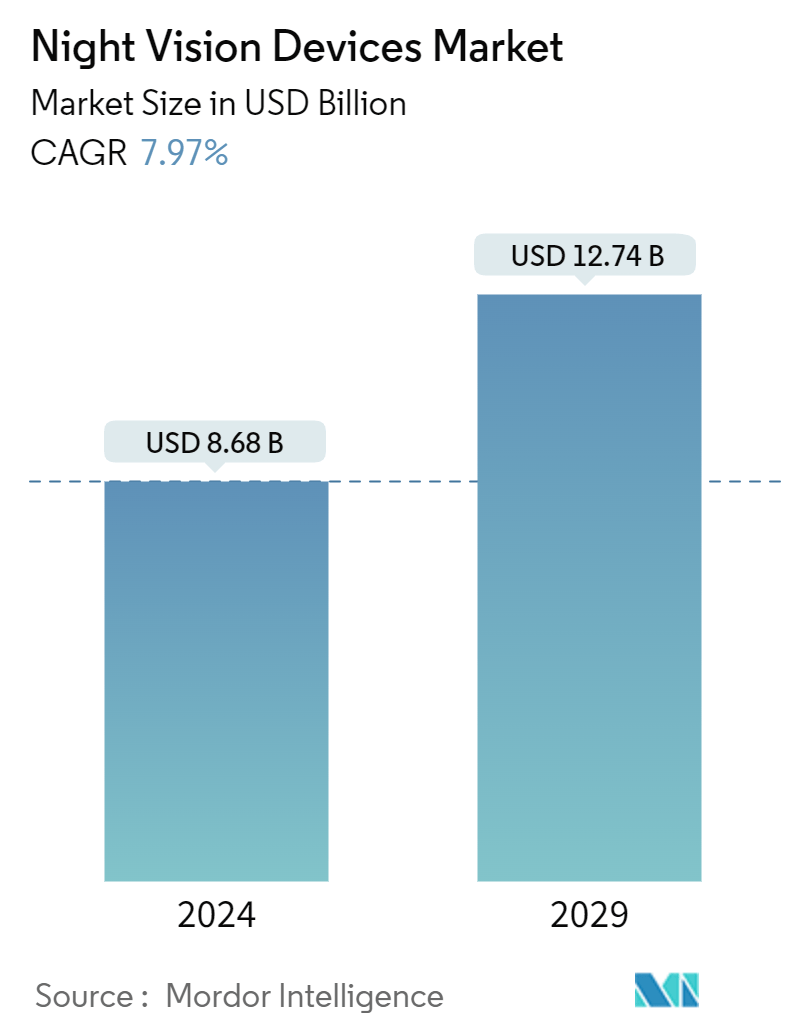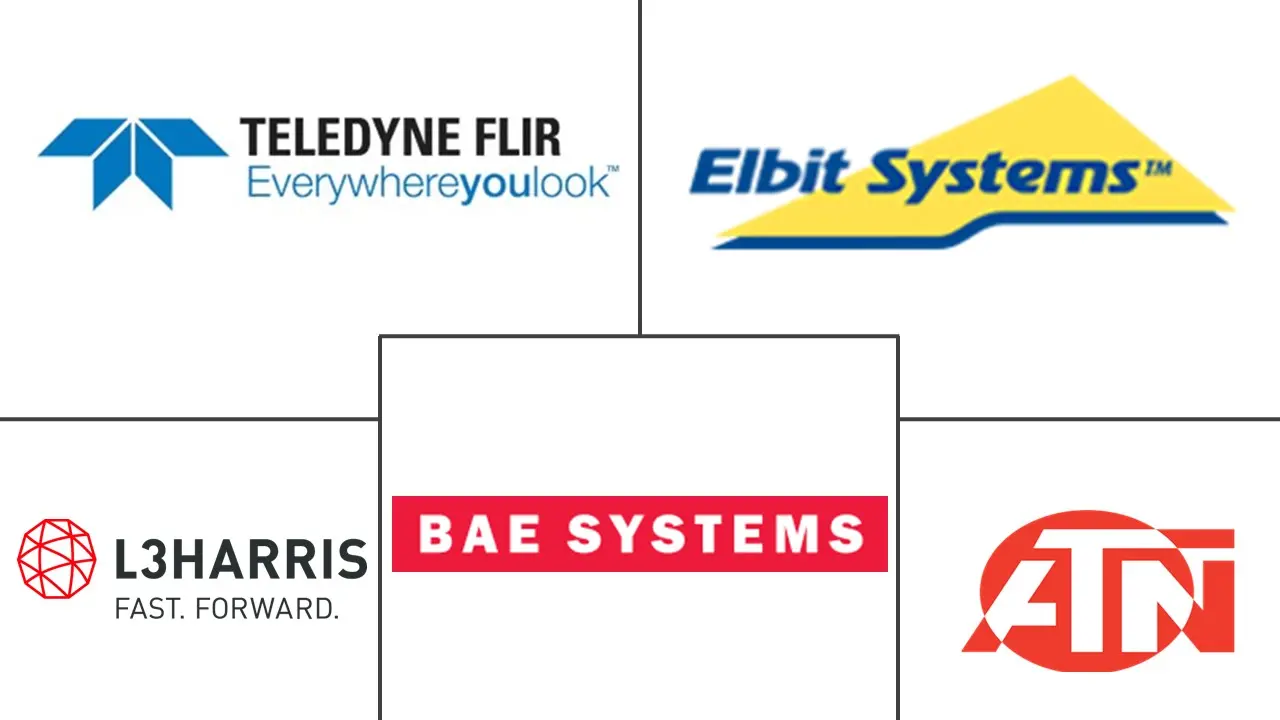Market Size of Night Vision Devices Industry

| Study Period | 2019 - 2029 |
| Market Size (2024) | USD 8.68 Billion |
| Market Size (2029) | USD 12.74 Billion |
| CAGR (2024 - 2029) | 7.97 % |
| Fastest Growing Market | Asia Pacific |
| Largest Market | North America |
Major Players
*Disclaimer: Major Players sorted in no particular order |
Night Vision Devices Market Analysis
The Night Vision Devices Market size is estimated at USD 8.68 billion in 2024, and is expected to reach USD 12.74 billion by 2029, growing at a CAGR of 7.97% during the forecast period (2024-2029).
Night vision is often employed in night surveillance at low-light security or completely dark conditions. Infrared cameras with night vision capabilities are excellent for anyone who needs to monitor in the dark for work or pleasure. Infrared cameras use infrared light (illuminator) rather than the usual illumination spectrum to create better photos in complete darkness or low light conditions. Many security systems now include both day and night versions of cameras.
• The night vision equipment provides soldiers with color visuals in low-light situations on the battlefield. These devices have acquired appeal among wildfire experts in recent years, which is expected to increase demand for the devices. The demand was fueled by technological and application feasibility, such as head-mounted night vision and low cost. These gadgets provide clear visibility of more than 150 to 200 yards at night.
• A major factor driving the market's growth is the growing military expenditure. As the global security threat deepens owing to issues such as terrorism, illegal migration, etc., countries across the globe are increasing their military expenditure to equip their protection forces with the latest technology devices, arms, and ammunition. For instance, according to SIPRI, the global military expenditure reached USD 2.240 trillion in 2022, compared to USD 1.807 trillion in 2017. With expenditures on military modernization anticipated to grow, such trends are anticipated to create a favorable ecosystem for the market’s growth.
• However, the higher cost and technical limitations of night vision devices, such as their limitations in targeting through transparent obstacles, continue to remain among the major challenging factors for the growth of the market studied.
• The global outbreak of COVID-19 has had a notable impact on the growth of the market studied. For instance, during the initial days of COVID-19, the global supply chain of various industries was disrupted, resulting in a scarcity of raw materials and components used in manufacturing and other industrial applications. Furthermore, restrictions imposed on the use of manual workforce further intensified the pandemic’s influence. During the pandemic, organizations across different end-user verticals also were averted on spending high on less crucial requirements. Hence, the market witnessed a slowdown.
• However, with the conditions gradually improving and supply chain pressure easing out, industries across different sectors reported growth, which is anticipated to be the case going forward as the influence of the pandemic on different verticals has been reducing, leading to the normalization in the market conditions both in terms of demand and supply. As a result, the market's growth in the post-COVID-19 period appears promising.
Night Vision Devices Industry Segmentation
The scope of the study focuses on the market analysis of night vision devices sold across the globe, and market sizing encompasses the revenue generated through night vision devices sold by various market players. The study also tracks the key market parameters, underlying growth influencers, and major vendors operating in the industry, which supports the market estimations and growth rates over the forecast period. The study further analyzes the overall impact of COVID-19 on the ecosystem. The scope of the report encompasses market sizing and forecast for segmentation by type, technology, application, and geography.
The night vision devices market is segmented by type (camera, goggles, monoculars and binoculars, rifle scope, and other types), by technology (thermal imaging, image intensifier, infrared illumination, other technologies), by application (military and defense, wildlife spotting and conservation, surveillance, navigation, other applications), and geography (North America, Europe, Asia-Pacific, Latin America, Middle East and Africa). The report offers market forecasts and size in value (USD) for all the above segments.
| By Type | |
| Camera | |
| Goggles | |
| Monoculars and Binoculars | |
| Rifle Scope | |
| Other Types |
| By Technology | |
| Thermal Imaging | |
| Image Intensifier | |
| Infrared Illumination | |
| Other Technologies |
| By Application | |
| Military and Defense | |
| Wildlife Spotting and Conservation | |
| Surveillance | |
| Navigation | |
| Other Applications |
| By Geography | |
| North America | |
| Europe | |
| Asia Pacific | |
| Latin America | |
| Middle East and Africa |
Night Vision Devices Market Size Summary
The night vision devices market is poised for significant growth, driven by increasing military expenditures and advancements in technology. These devices are essential for military operations, providing soldiers with enhanced visibility in low-light conditions, which is crucial for surveillance and threat detection. The market is also witnessing a surge in demand from various sectors, including automotive and aviation, where night vision systems are used to improve safety and operational capabilities in low-light environments. The integration of night vision technology with machine learning and augmented reality is further enhancing the functionality and appeal of these devices. Despite challenges such as high costs and technical limitations, the market is expected to expand as governments and industries continue to invest in advanced security and defense solutions.
The market landscape is semi-consolidated, with major players like Teledyne FLIR LLC, L3harris Technologies Inc., and Elbit Systems Deutschland leading the charge through strategic partnerships and innovations. Recent developments, such as the introduction of advanced night vision goggles and thermal weapon sights, underscore the ongoing commitment to enhancing military capabilities. The post-COVID-19 recovery has also contributed to market growth, as supply chain issues have been resolved and demand has normalized. As regional governments focus on improving their night vision capabilities through research and development, the market is set to benefit from increased adoption across military, defense, and civilian applications.
Night Vision Devices Market Size - Table of Contents
-
1. MARKET INSIGHTS
-
1.1 Market Overview
-
1.2 Industry Attractiveness - Porter's Five Forces Analysis
-
1.2.1 Bargaining Power of Suppliers
-
1.2.2 Bargaining Power of Buyers
-
1.2.3 Threat of New Entrants
-
1.2.4 Threat of Substitutes
-
1.2.5 Intensity of Competitive Rivalry
-
-
1.3 Industry Value Chain Analysis
-
1.4 Assessment of the Impact of Macroeconomic Trends on the Market
-
-
2. MARKET SEGMENTATION
-
2.1 By Type
-
2.1.1 Camera
-
2.1.2 Goggles
-
2.1.3 Monoculars and Binoculars
-
2.1.4 Rifle Scope
-
2.1.5 Other Types
-
-
2.2 By Technology
-
2.2.1 Thermal Imaging
-
2.2.2 Image Intensifier
-
2.2.3 Infrared Illumination
-
2.2.4 Other Technologies
-
-
2.3 By Application
-
2.3.1 Military and Defense
-
2.3.2 Wildlife Spotting and Conservation
-
2.3.3 Surveillance
-
2.3.4 Navigation
-
2.3.5 Other Applications
-
-
2.4 By Geography
-
2.4.1 North America
-
2.4.2 Europe
-
2.4.3 Asia Pacific
-
2.4.4 Latin America
-
2.4.5 Middle East and Africa
-
-
Night Vision Devices Market Size FAQs
How big is the Night Vision Devices Market?
The Night Vision Devices Market size is expected to reach USD 8.68 billion in 2024 and grow at a CAGR of 7.97% to reach USD 12.74 billion by 2029.
What is the current Night Vision Devices Market size?
In 2024, the Night Vision Devices Market size is expected to reach USD 8.68 billion.

